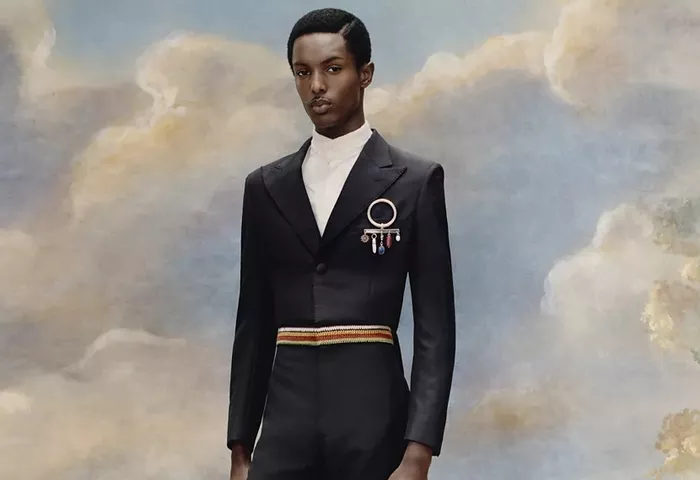This spring, the Costume Institute at New York’s Metropolitan Museum of Art presents a landmark exhibition, Superfine: Tailoring Black Style, which celebrates the long-standing tradition of black dandyism — a fashion movement that has allowed black men to express pride, resistance, and individuality through bold tailoring and vibrant attire.
The exhibition explores how black dandyism — the art of refined, flamboyant male dress — transcends mere fashion to become a powerful act of cultural and political self-definition. More than just a celebration of style, it represents a centuries-old resistance to dehumanization and an assertion of identity. The exhibition draws heavily from Monica L. Miller’s 2009 book Slaves to Fashion, which investigates how clothing has historically served as a canvas for reimagining black identity in the face of imposed definitions.
At its core, black dandyism emerged as a counter-narrative to the initial condition of enslaved Africans who, arriving in America stripped of clothing and identity, were subjected to enforced conformity. Miller explains that the enslaved, forced into uniform garments, immediately began personalizing their attire with small alterations — buttons, ribbons, and tailoring — laying early foundations for dandyism as resistance.
The exhibition showcases how this fashion movement evolved over more than 300 years, with contributions from across the black Atlantic world. In its modern incarnation, the Met Gala has embraced the exhibition’s themes, adopting “Tailored for You” as this year’s dress code. Co-chairs of the gala include actor Colman Domingo, F1 driver Lewis Hamilton, rapper A$AP Rocky, and musician Pharrell Williams, alongside Vogue editor Anna Wintour and basketball legend LeBron James.
The display features a wide range of items, from garments and photographs to artworks and films, examining 12 key traits of dandyism, such as Ownership, Heritage, and Beauty. The term “superfine,” Miller notes, refers both to a luxurious fine wool and the emotional power embedded in how people dress.
A key historical figure in the exhibit is Julius Soubise, a formerly enslaved man in 18th-century Britain. After gaining his freedom, Soubise used exaggerated dandy style — diamond-buckled shoes, lace, and perfume — to satirize and subvert the very stereotypes imposed upon him. His presence challenged rigid social categories and demanded a reimagining of black masculinity and social potential.
Elsewhere, dandyism served practical and liberatory purposes. William and Ellen Craft’s 1848 escape from slavery involved Ellen disguising herself as a white male aristocrat, aided by carefully chosen garments and accessories. Her husband, William, posed as her servant. Their story, detailed in William’s memoir, is another example of how fashion helped subvert oppressive structures.
Following the abolition of slavery in 1865, black Americans migrated northward, forming urban communities like Harlem, where the Harlem Renaissance of the 1920s and ’30s turned dandyism into a cultural and political statement. In the 1917 Silent Protest Parade in New York, thousands of black Americans marched in sharply tailored attire, using elegance and control to demand justice and dignity.
The suit is a central motif in the exhibition, symbolizing continuity through black fashion history — from livery to zoot suits. The zoot suit, popularized in Harlem in the 1930s and worn by icons like Dizzy Gillespie and Malcolm X, became a symbol of black confidence and space-taking. Despite backlash during wartime fabric rationing, the zoot suit endured as a bold expression of resistance, later influencing styles like MC Hammer’s baggy pants in the 1980s.
Fashion legend André Leon Talley, Vogue’s first black creative director, is also featured. A photograph of Talley in a checked suit captures his ethos: fashion as autobiography, fantasy, and rebellion. As Anna Wintour describes, Talley’s garments communicated his history, elegance, and playfulness — asserting self-worth in an industry historically dominated by whiteness.
Contemporary artists and designers continue the legacy. Nigerian-American artist Iké Udé’s Sartorial Anarchy portraits mix styles from different eras and geographies, blending homage and critique in a distinctly cosmopolitan voice. Designer Foday Dumbuya’s label Labrum reflects his immigrant experience and African heritage through sharp tailoring and inventive fabric prints that include immigration documents.
Miller emphasizes that black dandyism is dynamic, shaped by continuous adaptation. “Black people are always trying to outrun stereotype and appropriation,” she says. “It’s very much like a jazz riff — someone lays it down, someone else picks it up, transforms it, and creates something new.”
Related Topics
- Olivia Dunne Stuns Fans with ‘Pretty Woman’-Inspired Look at Kentucky Derby
- Kurdish Man Detained for Wearing Traditional Clothing at Son’s Wedding
- Refresh Your Summer Wardrobe with Trendy Women’s Shorts in Amazon’s Great Summer Sale

